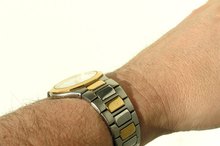What does fact checked mean?
At Healthfully, we strive to deliver objective content that is accurate and up-to-date. Our team periodically reviews articles in order to ensure content quality. The sources cited below consist of evidence from peer-reviewed journals, prominent medical organizations, academic associations, and government data.
The information contained on this site is for informational purposes only, and should not be used as a substitute for the advice of a professional health care provider. Please check with the appropriate physician regarding health questions and concerns. Although we strive to deliver accurate and up-to-date information, no guarantee to that effect is made.
How to Treat Diesel Fuel Skin Infection
When your skin is directly exposed to an irritant such as diesel fuel, it can develop an uncomfortable case of contact dermatitis. Symptoms of contact dermatitis include itching, redness, swelling and rash 1. Contact dermatitis may also cause oozing and crusting lesions or ulcerations to develop on the skin. Open lesions are susceptible to bacterial infection if not properly treated.
Wash the areas of skin that have been exposed to diesel fuel thoroughly with mild soap and warm water. Pat dry with a clean towel.
How to Treat a Salicylic Acid Burn
Learn More
Apply an over-the-counter corticosteroid cream or ointment, such as Cortizone-10 or Aveeno Hydrocortisone cream, to irritated skin to reduce itching and inflammation.
Keep any sores or lesions that develop clean and covered at all times. If infection is suspected, apply a thin layer of antibiotic ointment and cover with a sterile bandage. Proper home treatment can help to reduce your chances of developing a more serious bacterial infection.
How to Use Cornstarch to Relieve an Itchy Skin Rash
Learn More
Avoid direct contact with diesel fuel in the future, especially during the two to three weeks after developing dermatitis. Repeated exposure to skin irritants before contact dermatitis has healed can worsen the condition.
Warnings
If contact dermatitis worsens, becomes hot to the touch or you develop symptoms such as fever, malaise or nausea, consult your doctor. You should not attempt to treat serious skin infections at home; prescription antibiotic pills and/or ointments may be needed.
Related Articles
References
- Medline Plus Medical Encyclopedia: Contact Dermatitis
- U.S. Department of Labor--OSHA Division: Chemical Sampling Information for Diesel Fuel
- American Academy of Dermatology Association. Contact Dermatitis: Signs and Symptoms.
- Aquino M, Rosner G. Systemic Contact Dermatitis. Clinical Reviews in Allergy and Immunology. 2019 Feb;56(1):9-18. doi:10.1007/s12016-018-8686-z
- Mowad CM, Anderson B, Scheinman P, Pootongkam S, Nedorost S, Brod B. Allergic Contact Dermatitis: Patient Management and Education. Journal of the American Academy of Dermatolgy. 2016 Jun;74(6):1043-54. doi:10.1016/j.jaad.2015.02.1144
- Pelletier JL, Perez C, Jacob SE. Contact Dermatitis in Pediatrics. Pediatric Annals. 2016 Aug 1;45(8):e287-92. doi:10.3928/19382359-20160720-06
- Rashid RS, Shim TN. Contact Dermatitis. BMJ. 2016 Jun 30;353:i3299. doi:10.1136/bmj.i3299
Warnings
- If contact dermatitis worsens, becomes hot to the touch or you develop symptoms such as fever, malaise or nausea, consult your doctor. You should not attempt to treat serious skin infections at home; prescription antibiotic pills and/or ointments may be needed.
Writer Bio
Heather Kimbrell began writing professionally in 2009. Most of her work is featured online, where she publishes health and technology articles. She is a certified medical assistant and a part-time PC technician. Before pursuing a medical-assisting career, she received information technology training from Cisco Networking Academy. Kimbrell earned an associate degree in medical assisting from Fortis College of Montgomery, Ala.






